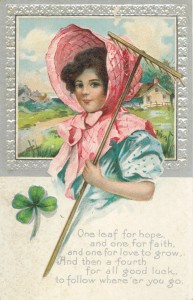As many of you already know, I love hunting for treasures. While the term usually implies that objects of some antiquity are involved, they need not be valuable, nor even beautiful, to be treasures to me. For me, their stories make them precious and what better way for them to reveal their stories than through the written word.
This month, I went to an antique show and sale. It had a flea market feel to it, crowded and chaotic. I wandered the aisles, casually scanning the articles on display. I paused at a few tables to ask questions about items and continued my ramble. Eventually, at a table with a vast assortment of objects that appeared to have only the characteristic of portability in common, I found my treasure. It was a small box of vintage postcards.
I stopped to peer into the box, looking at each card front, and if it was appealing, flipping it over to read the reverse. Eventually, I chose a few and purchased them for the modest fee of one dollar apiece. Can one even get a modern postcard for that small sum? (To me, the value of a treasure increases if it is a bargain on top of its other good qualities!) I was thrilled with my discovery. The ones I selected had lovely printed floral designs and quaint verses. Not all had actually been mailed, but some had and I could imagine the postmaster wielding the inky stamp and thumping it onto the back of the card to cancel the postage. Of course, the advantage here was that the message was thus dated. As suggested by their design, the cards proved to be from the beginning of the last century. Most of the cards were mailed in the United States to people in unheard of settlements, which was a trifle unfortunate. However, I did find a photo postcard of “Morning Mists on Lake Louise,” so, being familiar and local, it obviously had to come home with me. Some of the postcards were inscribed with cute Valentine and birthday messages, too.
Tucking the cards gingerly into my bag, I went home with a perky step. One day, I may see if I can find out more about the names that appear on my cards, but for now they are a romantic mystery.
Then today, I came across a news item you may have heard about: an actual treasure chest of undelivered letters from the late 17th-century, recently discovered in a Dutch museum. The music professor from Yale, Rebekah Ahrendt, who found it was interviewed on As It Happens November 10, 2015.
These letters sent off to friends, colleagues, or family by a wide assortment of individuals, stalled at The Hague and could not be delivered those many years ago. Either the recipients could not be found or refused to take delivery (which required they pay the remaining postage charge). The postmaster kept the letters in hopes that by and by someone would come to pay the delivery fee. Eventually, the large chest made its way into a museum, where it was recently made available to a team of scholars.
The chest contains about 2600 letters, written in regional dialects of six languages. Included with them are postal accounts, illuminating how the postal system worked at that time. One quirk of the system was that envelopes were not used; the paper of the letter itself was folded and then sealed with wax. The wax seals alone are interesting, impressed with ornate designs or even the fingerprint of the sender.
Of the letters in the chest, 600 are still unopened and researchers are looking at new technology (e.g. X-ray microtomography) to try to read them without breaking their seals and unfolding the origami-like creases. In fact, some of the previously opened letters were found to have been refolded incorrectly in the past (just like the old maps in the back of your vehicle’s glove compartment). The various methods of folding may be related to the contents of the letter, with the most intricately folded signifying messages that had to be kept from prying eyes (perhaps communiques between spies?).
This treasure trove of letters has many stories to tell, on the large and small scale – from the workings of societal systems and social customs, to the intimate thoughts exchanged between lovers. I hope to read more about this project in the future. If you are interested in seeing more now, check out the photos in the Smithsonian Magazine article.
Here’s hoping you are lucky enough to find your own treasure this month. Perhaps it will be a message mailed long ago. On that note, here is a verse from one of my new/old cards:

This article was originally printed in the BERGEN NEWS and is being reprinted with permission.